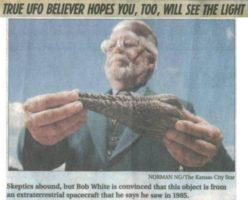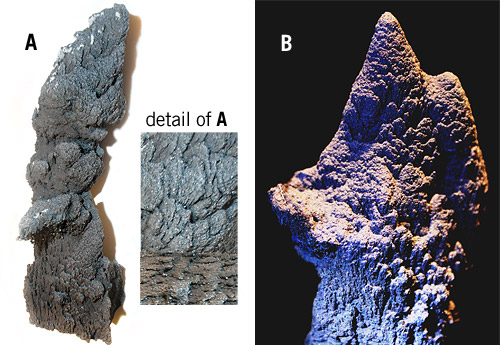By Charles Lear
In last week’s blog, we looked at metals associated with UFO reports that were held up as evidence for extraterrestrial visitation. The cases we examined were from the early days of the UFO mystery and in this week’s blog we’ll look at one that is more recent.
 According to Robert Lee “Bob” White, in 1985 (the specific date doesn’t seem to appear anywhere) he was riding in the passenger seat of a car being driven by his female traveling companion. White wouldn’t reveal her name, as she was married, but later gave her first name as “Jan.” They had left Denver, Colorado, and were headed for Las Vegas, Nevada. Between 2 a.m. and 3 a.m., near the Colorado-Utah border, his friend woke him and pointed out a light up ahead. White went back to sleep until his friend woke him again. According to White, the light was extremely bright at this point. He described seeing a lighted object about 100 yards away that was “absolutely huge.” His friend turned on the high beams, and the object shot up. It moved between two, blue lights that looked like horizontal fluorescent tubes. All the lights sped off, and as they did so, White saw a flash, and a small, glowing object fell to earth.
According to Robert Lee “Bob” White, in 1985 (the specific date doesn’t seem to appear anywhere) he was riding in the passenger seat of a car being driven by his female traveling companion. White wouldn’t reveal her name, as she was married, but later gave her first name as “Jan.” They had left Denver, Colorado, and were headed for Las Vegas, Nevada. Between 2 a.m. and 3 a.m., near the Colorado-Utah border, his friend woke him and pointed out a light up ahead. White went back to sleep until his friend woke him again. According to White, the light was extremely bright at this point. He described seeing a lighted object about 100 yards away that was “absolutely huge.” His friend turned on the high beams, and the object shot up. It moved between two, blue lights that looked like horizontal fluorescent tubes. All the lights sped off, and as they did so, White saw a flash, and a small, glowing object fell to earth.
White went to investigate and saw a long groove in the desert floor. At the end of it, he saw a small, teardrop-shaped, glowing piece of metal. He waited for it to cool off and then picked it up and put it in the trunk of the car.
White came forward with his story in 1996 after his retirement from a career in music under the name of Frank James. In 1998, he signed an affidavit attesting to his story and passed a polygraph test. This is according to a message announcing the death of Bob White in 2009 sent by White’s friend and business partner, Larry Cekander, to members of UFO HUNTERS Museum of the Unexplained.
The artifact was first presented to the public at the annual Ozark UFO Conference in Eureka Springs, Arkansas. For five dollars, those wishing to view the object would be escorted behind a curtain where White would do a show and tell. If anyone was interested in purchasing the object, White set a price of $10,000,000.
 Testing of the metal by the New Mexico Institute of Mining and Technology was arranged by Robert Bigelow’s organization, the National Institute for Discovery Science, in 1996. According to NIDs scientist Colm Kelleher, the results were “pretty mundane.” Kelleher stated: “We didn’t find any evidence that it was extraterrestrial. Now, you can make the argument that we didn’t spend $1 million and look at every conceivable option. We didn’t cover every base.” NIDs concluded that the metal was very similar to an aluminum alloy known as “360 Aluminum Casting Alloy.”
Testing of the metal by the New Mexico Institute of Mining and Technology was arranged by Robert Bigelow’s organization, the National Institute for Discovery Science, in 1996. According to NIDs scientist Colm Kelleher, the results were “pretty mundane.” Kelleher stated: “We didn’t find any evidence that it was extraterrestrial. Now, you can make the argument that we didn’t spend $1 million and look at every conceivable option. We didn’t cover every base.” NIDs concluded that the metal was very similar to an aluminum alloy known as “360 Aluminum Casting Alloy.”
White and Cekander, himself a metal worker, dismissed the findings and arranged for more tests. According to them, the results showed an “off earth” origin for the metal, but the scientists involved refused to state this publicly.
The two men opened up the “Museum of the Unexplained” in 2000 to display the object. The museum was housed in a former video rental store on Main Street in Reeds Spring, Missouri. The object was the centerpiece surrounded by newspaper articles and printouts from the web related to it, thumbtacked to the walls. The museum attracted few paying visitors and closed in 2004.
As sketchy as this story might seem, White and Cekander went to extensive lengths to offer proof that the artifact is unique. Cekander has a website that documents the tests that were conducted and includes the names and statements of scientists who agreed that the object possessed unusual properties.
Missouri State University Graduate Student David M. Lamb did an x-ray diffraction and micro x-ray analysis in 2009. The micro x-ray analysis showed an “unusual high rate of silicon and silver.” The x-ray diffraction showed aluminum peaks where they would be expected, but one was 47% higher than normal. According to Lamb, the peak indicates a polycrystalline structure not found in normal aircraft aluminum.
Even before the tests, Lamb found the object’s feathered texture to be unusual. He notes that the high silicon content would make the metal resistant to corrosion and change the melting temperature. He speculates that this could account for the feathered texture if the piece entered the earth’s atmosphere from the vacuum of space.
Lamb also speculates about the silver content. According to him, the silver could have been added to enhance superconductivity. Such a metal used for space travel “may work well to increase velocities and eliminate the drag of magnetic fields.”
Chris Ellis, a physicist, also studied the object. He determined it was not carved or cast. To him, the object’s shape and structure was consistent with what one would expect of a metal heated close to its melting point and then subjected to an intense airflow.
Ellis had tests run at a lab in Kentucky to determine what elements were present. Two tests determined there were 19 elements in total. In contrast to Lamb’s results, there was no silver detected.
Tests were done at SELEE labs in North Carolina in 2015. Lab Manager Dr. Rudolph Olsen described the object this way: “… I think you can say it is an agglomeration of rapidly cooled droplets/particles of an aluminum silicon alloy with such an unusual structure, I can only speculate how it was formed.”
Dr. Robert Gibbons, a fellow Missouri resident, joined the Museum of the Unexplained research team and helped them conduct their own tests. In particular, they were interested in why a hotel safe’s batteries were drained three times in a row when the object was housed in it. Gibbons surrounded the object with x-ray film and two black spots appeared on the film that was under the base. The spots seemed to line up with the object’s two lobes.
Lamb, Ellis and Gibbons all appeared with White on the History Channel show, “UFO Hunters.” They described their findings and particular attention was paid to Lamb’s speculation that the presence of silver in the object would have made the metal ideal for use in space travel.
White, Cekander, and Gibbons all became active in the UFO community and found supporters for White’s claim. These included Peter Davenport, Ted Phillips and John Greenewald, Jr.
 In November 2011, Skeptic magazine Volume 16 Number 3 carried an article co-authored by Pat Linse and Ean Harrison claiming a solution to the mystery object. Harrison is identified as a retired steel foundry quality control supervisor. According to him, the object is similar to metal accreted on the guards of stationary grinders. The examples shown, however, are steel and not aluminum, and in this writer’s opinion, aren’t a close enough match to White’s object to be held up as the solution to the mystery.
In November 2011, Skeptic magazine Volume 16 Number 3 carried an article co-authored by Pat Linse and Ean Harrison claiming a solution to the mystery object. Harrison is identified as a retired steel foundry quality control supervisor. According to him, the object is similar to metal accreted on the guards of stationary grinders. The examples shown, however, are steel and not aluminum, and in this writer’s opinion, aren’t a close enough match to White’s object to be held up as the solution to the mystery.
This case has its detractors and there are definitely indications that it might be a hoax; Cekander was a metal worker himself and could have conceivably manufactured the object, and White did attempt to profit from it. Another problem with the case is that it rests on the testimony of White, who never identified his traveling companion’s full name. On the other hand, Cekander presents a good deal of intriguing evidence, and the fact remains that no one has produced anything that looks like the object. It seems to be truly unique and how it was produced remains a mystery.